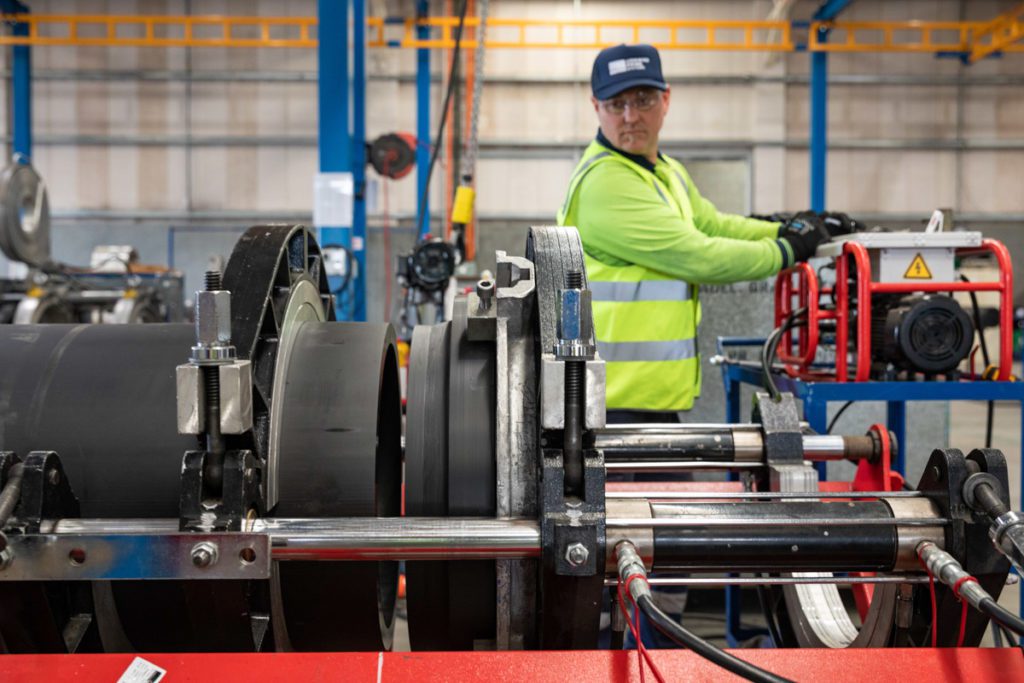An expert’s advice on welding poly pipe

When welded and joined correctly, poly pipes are the most leak-proof piping system on the market, according to industry expert and Polysmart trainer, Darren Poynton.
Darren launched his pipe welding company 26 years’ ago, and for the past 10, has been imparting his expert knowledge to the next generation of welders through poly pipe welding training.
Throughout his career, Darren has seen the impact of failed welds – major infrastructure damage, financial and personal harm, and community health issues – and is passionate about ensuring incidents like this are avoided at all costs.
To ensure the quality and success of your next weld, read through his advice for welding poly pipe.
Understanding the different techniques for welding poly pipe
Poly pipe can be welded using butt welding, or electrofusion welding.
Poly pipe butt welding melts and fuses the actual pipe, without using a filler material or solvent, making it a totally homogenous joint.
With electrofusion welding, a fitting with implanted metal coils is placed around the ends of two pipes that need to be joined, and a current is passed through the coils. By heating the coils, small amounts of the pipe and fitting are melted, and upon solidification, a joint is formed.
Darren says it’s generally best to use butt welding for most scenarios, as opposed to electrofusion welding.
“When applicable, my advice is to use butt welding in every case as it displays less likelihood of failure due to poor practices,” he said.
“With butt welding, you also don’t need as many individual items, as the welders themselves come with all the items you need, besides maybe some pipe stands.
“You should only use electrofusion welding when you physically cannot use a butt welder, such as between two fixed points, in tight conditions or in undertaking overhead pipe works.
“In addition, electrofusion welding needs several specialised ancillary tools as well as the electrofusion welder.”
Extrusion welding and hot air welding are also methods for joining poly pipe, but rarely used in joining pipe for pressure applications, such as water or gas mains.
Darren’s top five tips for butt welding poly pipe
1. Ensure the correct parameters are used – ensure your pipes are joined for the right time, and with the right pressure, to ensure a successful weld. Not sticking to procedures and parameters is the most common mistake people make when butt welding.
2. Ensure your machinery is in good condition – defective, or sub-standard machinery may affect the quality of your weld.
3. Make sure the pipe is well aligned – when your pipes are placed in the butt welding machine, ensure they are clamped in correctly, and line-up to one another.
4. Make sure pipe ends are cleaned and planed correctly – residue or uneven pipe ends will impact the quality of your weld.
5. Use accredited staff – anyone butt welding pipe must have completed an accredited poly pipe welding training course.
Darren’s top five tips for electrofusion welding poly pipe
1. Pipe must be cleaned – unclean pipe, generally caused by oil residue or dirt, is the most likely reason for failure in electrofusion welding and will result in a contaminated weld.
2. Peeling must be done correctly, removing at least 0.2mm off the surface – without correct and accurate peeling, failures will occur in the weld.
3. Pipes must be fully inserted into fittings – molten backflow will result if pipe hasn’t been fully inserted into a fitting.
4. Alignment and rounding tools must be used – once pipe has been fully inserted into its fitting, you must ensure it is correctly aligned and rounded.
5. Use accredited staff – anyone electrofusion welding pipe must have completed an accredited poly pipe welding training course.
A final “weld” of wisdom
While no one enjoys paperwork, Darren says it could save you in the long run, should you need to repair a failed weld.
“Electrofusion and butt welding are an extremely efficient and reliable way to join poly pipe,” he said.
“However, attention to detail and record keeping is extremely important, so I would strongly suggest detailed weld data recording for every weld.
“Over the last 15 years, I have had many failed welds sent to me for failure evaluation – but none of these had weld records provided.”
Register for Advanced Piping Systems poly welding training
Advanced Piping Systems recommends poly welding be conducted by trained and accredited personnel.
We offer training courses to improve your knowledge and become nationally accredited in Butt and Electrofusion Welding of Polyethylene pipelines.
These courses are regularly held at our Adelaide training facility or can be held at any suitable site location.Enquire today about the next available course.

